
Diary: The garden in January 2000

 | Diary: The garden in January 2000 |

|
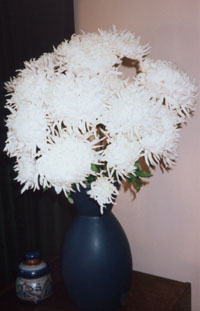
On the 1st, of the New Millennium Year, Patricia picked the last of the chrysanthemums in our greenhouse. Snowshine, a pure white incurving decorate, was the last of the several varieties that we grow for flowering between October and the New Year. Our other end-of-season variety is another pure white reflex Arctic Beauty. Sadly, neither of these varieties is in the current catalogue, but does not matter as we propagate our own cuttings.
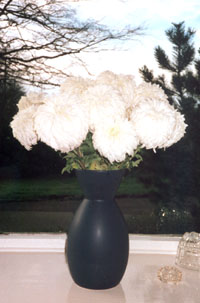
The 2nd was dull and drizzly but I spotted some bullfinches in one of the wild areas of the garden. They, possibly 2 males and a female, were seen feeding for a while on snowberry and plum taking buds. For some years we have seen pairs at this time of year and were glad to see them again, as they have become quite rare. Snowdrops, which have been showing green 1-2 cm above ground since December, have not grown much more but are now showing a few spots of white. Early varieties of Narcissus (daffodil) are in places 3-4 cm tall. The ground is very wet and no work can be done at present. In recent gales fallen leaves have blown away from some border shrubs, where they have gathered, but some remain in wet heaps covering some plants and will have to be removed to the leaf heap. When further decomposed the leaf mould will be used for mulching and potting later in the year.
The 9th saw the appearance of first few snowdrops, they suddenly seemed to have sprung up and are in flower in grass bordering the small rhododendron garden at the front of the house. The soil here is slightly acidic and there is no problem in growing rhododendrons and azaleas.
![Document of sale of Gadlys Estate in 1882.[15KB] Document of sale of Gadlys Estate in 1882.[15KB]](graphics/gdsale1.gif)
This garden was planted 3 years ago and has proved to be a success. We chose varieties not only for their flower colour but also their leaf shape and colour. This gives a lot of interest at any time of the year. The garden is well planted with snowdrops, which have naturalised in several areas. These, and several varieties of daffodils, were already growing in the garden when we came to live here in 1971. From time to time we do our bit for the future garden and plant some more. Last autumn we planted a patch with some dwarf varieties, these too are beginning to show a little green above ground. The house is the former Front Lodge of a country estate. Records of sale catalogues show that the estate was sold in 1882 and again in 1902. The house seems to have been built, by the then new estate owners, around 1884; we found the date under several layers of wallpaper. The Lodge is not marked on the 1882 documents but is on those dated 1902. A previous recent owner of the Lodge until about 1969, a Mrs Viner had a garden, a greenhouse and kept bees. There was not much left of the garden when we arrived, the greenhouse had rotted and been dismantled and a few beehives were empty and in poor condition. The next owner had begun, but not quite finished, modernisation of the house. What was left of the garden had been more or less destroyed in the rebuilding process, so we had to start again from scratch.A garden is never finished, plants and borders mature and then need replanting. Some things are successful and others not, some grow too large and others not at all. Soon after we moved in Dutch elm disease appeared and many trees died or were felled in at attempt to stamp out the disease. These measures failed and all the mature elms were lost.
![Document of sale of Gadlys Estate in 1902.[17KB] Document of sale of Gadlys Estate in 1902.[17KB]](graphics/gdsale2.gif)
Today there remains just some scrub elm and regrowth from a few felled bases. These usually grow for a few years and then they are struck down once more. There has been a lot of natural regeneration in the wood but mainly of sycamore and Norway maple.
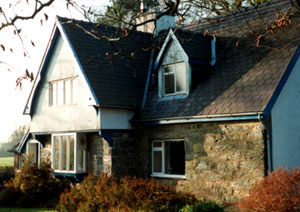
The 10-12th has been an exceptionally wet spell, the ground was already wet and there was a lot of runoff from the surrounding fields on to the road alongside the garden. A great spotted woodpecker was heard drumming in the tree quite close to the house on the 13th. These birds are around most of the time; we see them feeding at our peanut feeders. Since the autumn we have only seen male birds, distinguished by a bright red patch on their heads. The females, which do not have a red patch, seem to prefer to feed on natural material. They will now start to put in an appearance and, when nesting, will be more frequent visitors. Eventually, together with the male, they will bring their young to feed also. Also heard today was a tawny owl, just before dawn there was quite a lot of hooting from the large old sycamore close to the house on the south side. although the 14th was a sunny day there was a cold wind and the ground is still very wet so opportunity was taken to do some work in the greenhouse. As the chrysanthemums have finished, still in their 25 cm (10 in) pots, they were cut back to within 10 cm of the soil level. Some were already showing signs of new shoots from the base, the cutting back will encourage more new shoot production which later on will be used for cuttings to propagate next seasons flowers. Also in the greenhouse is a Muscat type grapevine, var. Black Hamburg.
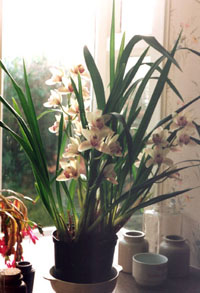
It is the same variety as the very large vine in Hampton Court planted in 1768. We planted ours here in 1976 when we erected the new greenhouse, but it was a cutting from a much older plant grown by Patricia's father in Hove, Sussex. The root is planted outside and the vine brought inside and trained along the length of the house. January is the month when it should be pruned.
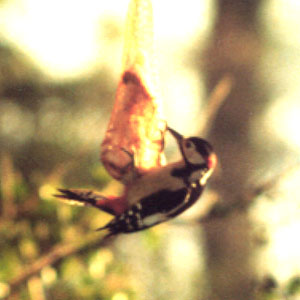
Basically this means that the side shoots, which grew last season, are cut back to a bud on the main stem. This job was done and the prunings gathered and, together with the fallen leaves and the cut chrysanthemum stems, consigned to the compost heap. During the day the ground dried considerably and by the next morning it felt firm to walk on and not spongy as it had for the past week. The 15th was another dry sunny day so work could be done out of doors. We have a few grapevines growing in the garden. These are more for decorative purposes as there are very few years that would successfully ripen grapes in this locality. Grapes have ripened in an old walled garden in the Conwy Valley and along the south-facing side of the Menai Straits. The grapes here have produced some grapes in 1 or 2 years, but they have never ripened. The vines were grown as short bushes; this is wrong, as even in northern France the vines are grown much taller. The reason is that it is much colder nearer the ground and the grapes stand a better chance when grown taller. For the last 2-3 years I have been growing and training the vines up to a height of 1.5 m. Today these vines were pruned to their new height, it will be interesting to see if they are more successful.
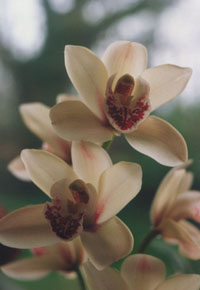
Flowering in the house this month are 2 species of orchid. The first, a Cypripedium, is a family heirloom. The original plant was given to my grandmother by her son Graham Wright in 1941. He was a bomb disposal officer in the RNVR (Royal Navy Volunteer Reserve) and was tragically lost at sea on board ship sailing in convoy for "the Rock", Gibraltar. Before leaving he safely defused a land mine, which had started ticking, lodged in the rafters of the Palladium theatre in London. He was awarded, posthumously, the George Medal. The orchid has had many family memories over four generations, at present we are the present keepers and propagators. It grows very well in our house and every year, from October to February, are rewarded by several blooms (7 this year). We have several plants, just in case.
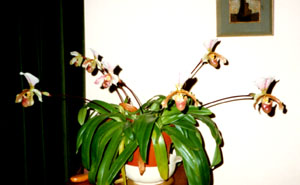
The other species, a more recent acquisition, is a Cymbidium. This is a much larger plant and resides on the large south (almost) facing window of our kitchen. The steamy (occasionally) atmosphere seems to suit orchids. Both species are kept here most of the year but the Cypripedium is moved to another room when flowering. We do not have a gas supply to the house; orchids (and some other plants) do not seem to thrive where gas is used.
The birds are singing much more this month. Until now only robins, wrens and great tits have been noticeable but the blackbirds now have joined these. There are several pairs of each around the garden and in the wood. On a quiet morning it is noticeable that the volume of singing has increased. Today, the 16th, these have been joined by 2 male mistle thrushes. After a few trial notes they got down to some serious singing and there were one or two disputes, as territories have to be established. We have had 2 pairs in the vicinity during the breeding season for a few years and they tend to dominate the singing. We usually have 1 or 2 pairs of song thrushes as well, although we have seen the odd one around, they have yet to appear regularly in the garden. Both the mistle and song thrushes tend to nest early and, although losses do occur in some years, the advantage is that if successful a second brood may be reared.
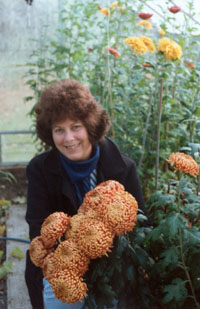
The anticyclonic weather has given us a drier spell but it has remained mainly cloudy. The morning of the 19th was typically cloudy and there was little wind. The mistle thrushes were singing from dawn for an hour or more and these were joined later by the drumming of the greater spotted woodpecker. A female woodpecker has now joined the male in coming to the peanut feeders so I expect they will be soon inspecting their nesting place. Woodpeckers have nested in the same tree for some years; this is across the road from our garden. As the woodland hereabouts is all joined-up, it is one habitat to birds and other animals. To them the fact that a source of food and their nesting tree is on different property does not concern them. The blackbirds, there are at least 3 pairs around in the garden and more along the woodland strips, are beginning to show an interest in a spot of singing but nothing to serious at the moment. This has been a mild January and we have not seen the redwings in the surrounding fields, seen in November and December. The solitary brambling, seen here for several days in November has not reappeared. There have been flocks of starlings feeding on the fields nearby. These often come and perch on tall trees bounding the fields. There is much twittering and then they will fly down to feed once more. So far the flock has not favoured our garden as they have in some years. Also feeding on the fields are the rooks. There are several rookeries nearby and on fine days nest inspection will take place. This is a very noisy affair as claims, and counter claims, are made for the best positions. The nests usually survive the winter gales but some are destroyed and most need rebuilding. This work has not yet started.
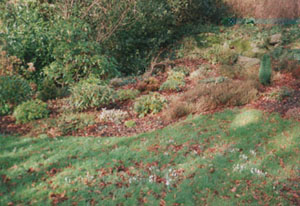
On the afternoon of 27th we saw a flock of 60 lapwings in a wet field on the road to Llanbedrgoch. This is the most seen since the 100 seen on 3 December 1999 near Rhoscefnhir. There were also some curlews, about 10 on this occasion, larger numbers were seen in the same field earlier in the winter. We do not see such large flocks on the fields surrounding the house. They are drier but also surrounded by the mature broadleaf shelterbelt woodland. Both the lapwing and curlew prefer the more open fields.
A walk around the garden today, the 25th, little or no wind and bright at times. A chance to see how the plants are growing. When we came to live here we brought with us many rooted cuttings of 'heathers'.
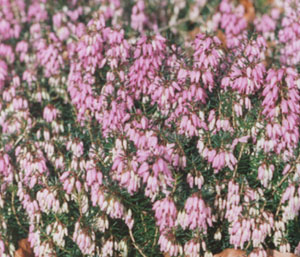
At our previous home we had established heather borders which proved very successful. We closely planted them here in swaths of different colour on slopes around the house. In flower at the end of the year was the Erica December Red and through this month the Erica carnea varieties Springwood White and Springwood Pink have been gradually coming into flower. The white is always the first and another the Springwood Red is much later. Also just showing colour, as part of the rhododendron garden is the deep rose-pink coloured Erica carnea Heathwood. This has been planted for 2 seasons and already the plants have a 25-cm spread that will soon join up. We have attempted, and largely succeeded, to have examples in flower throughout the year. The varieties of Erica carnea are easy to grow; they will tolerate some lime in the soil. Our soil here is slightly acidic is ideal and we can also grow some of the calcium intolerant species such as Calluna. Also coming into flower is the green hellebore Helleborus viridis. This is a deciduous plant, which can die back to ground level. In some mild winters some green leaves remain and it comes into flower very early. Rosemary is flowering and potted pelargoniums in a sheltered corner of the house still have some small flowers. The Camellia is a mass of buds and if the weather is favourable should give a good display later on. The snowdrops have continued to open and large patches look spectacular in the brief spells of sunshine. In the wood there was no sign of any emerging bluebell leaves but one or two patches of recently established snowdrops are doing well.
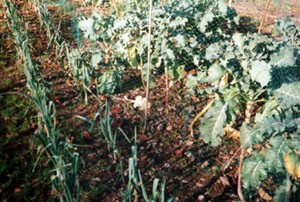
Inspection of the vegetable garden showed that the purple sprouting broccoli was doing well. It will be a few weeks before it sprouts and we can start picking. The leeks have been a bit disappointing this year, they are rather small but tasty never the less. Recent winds had dislodged netting, used to discourage wood pigeons from eating them, so I attended to this. Our vegetable garden is now smaller than it used to be. As our children
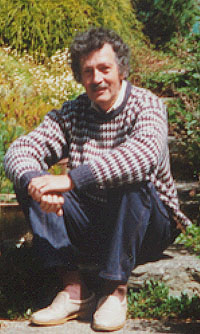
have left home we need less, but the main reason is we find the job of digging and weeding more difficult. So we have reduced its size by a third. We used to run it as a three-plot system, rotating every year as (1) potatoes and roots, (2) peas, beans and salad, and (3) brassicas. This used to work very well and over many years we have suffer little from disease. We are almost organic but do occasionally use some artificial fertilisers. We need very little pesticide application, only the minimum when absolutely necessary. Patricia has prepared the seed list for the season and orders have been placed. We keep our own seed of some things such as potatoes, runner beans and broad beans.
The mistle thrushes seem to have established their claim to parts of the woodland bordering the garden. The 28th dawned wet and windy, a gale was blowing from the southwest with quite heavy rain but this does not prevent the mistle thrushes singing. Perched on the topmost branches they have been singing since first light, occasionally moving to another nearby tree. They have sometimes been called 'storm cocks' and this seemed a most appropriate name for them today. They will build their nests high up in the trees long before any leaves have appeared. Later in the year they return to the wide-open spaces of fields, moors and marshes but at present we have the pleasure of their company.
On the last day, 31st, the first yellow crocus has appeared.
Document dated: 23 May 2000. This page is part of the site maintained at http://www.llansadwrn-wx.co.uk
Copyright ©: 2000 Donald and Patricia Perkins